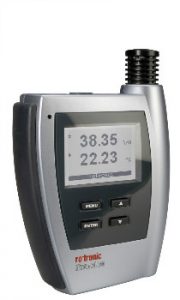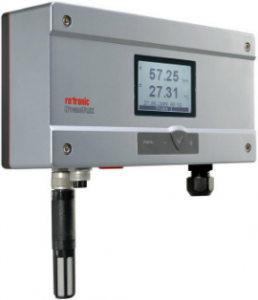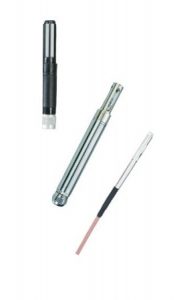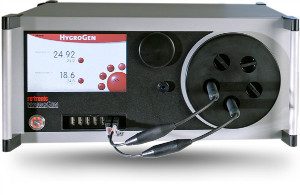Humidity Applications in Laboratories
Laboratories in General
A laboratory refers to a workplace, especially in the field of natural sciences. It is a facility that provides controlled conditions in which scientific research, experiments, and measuring may be performed.
In contrast to the office, the work in a lab is more hands on. This means that the various experiments, process controls and quality controls are carried out. The chemical materials are processed or chemical products are manufactured.
Laboratories can be found in many different industries such as pharmaceuticals, medicine and engineering. Labs are widespread in industrial manufacturing plants for quality control of incoming materials, performance of manufactured products and also for their own product development. Labs used for scientific research take many forms because of the differing requirements of specialists in the various fields of science. A physics lab might contain a particle accelerator or vacuum chamber, while a metallurgy lab could have apparatus for casting or refining metals or for testing their strength. A chemist or biologist might use a wet laboratory, while a psychologist’s lab might be a room with one-way mirrors and hidden cameras in which to observe behavior.
However, the most common humidity applications can be found in pharmaceutical laboratories. For almost all equipment chambers, such as autoclaves, incubators or clean rooms, humidity and temperature measurement are absolutely mandatory.
Applications with the Need to Measure Temperature & Humidity
Incubators
What is an incubator?
An incubator is a device used to grow and maintain microbiological cultures or cell cultures.
Why the need for an incubator?
Incubators are essential for a lot of experimental work in cell biology, microbiology and molecular biology and are used to culture bacterial as well as eukaryotic cells.
Why the need to measure humidity & temperature?
The incubator maintains optimal temperature, humidity and other conditions such as the carbon dioxide (CO2) and oxygen content of the atmosphere inside.
Climatic Chambers
What is a climatic chamber?
An environmental chamber is an enclosure used to test the effects of specified environmental conditions on biological items, industrial products, materials, and electronic devices and components.
Why the need for a climatic chamber?
An environmental test chamber artificially replicates the conditions under which machinery, materials, devices or components might be exposed. It is also used to accelerate the effects of exposure to the environment, sometimes at conditions not actually expected.
These conditions may include, extreme temperatures, sudden and extreme temperature variations, moisture or relative humidity, electrodynamic vibrations, electromagnetic radiation, and many more.
Why the need to measure humidity & temperature?
Manufactured samples, specimens, or components are placed inside the chamber and subjected to one or more of these environmental parameters to determine reliability or measure after-effects.
Autoclaves
What is an autoclave?
An autoclave is an instrument used to sterilize equipment and supplies by subjecting them to high pressure saturated steam at high temperatures for a certain period of time depending on the size of the load and the contents.
Why the need for an autoclave?
Autoclaves are found in many medical settings, laboratories, and other places that need to ensure sterility of an object. Typical loads include laboratory glassware, surgical instruments, medical waste, patient care utensils, animal cage bedding, and Lysogeny broth.
Why the need to measure humidity & temperature?
A medical autoclave is a device that uses steam to sterilize equipment and other objects. This means that all bacteria, viruses, fungi, and spores are inactivated.
Refrigerators and Freezers
What is a refrigerator?
A refrigerator is an appliance that consists of a thermally insulated compartment and a heat pump which transfers heat from the inside of the fridge to its external environment so that the inside of the fridge is cooled to a temperature below the ambient temperature of the room.
 Why the need for a refrigerator?
Why the need for a refrigerator?
Cooling is an efficient technique and works by decreasing the reproduction rate of bacteria.
Why the need to measure humidity & temperature?
To monitor and trace the stabilized conditions.
Clean Rooms
What is a clean room?
A clean room is an environment, typically used in manufacturing or scientific research, that has a low level of environmental pollutants such as dust, airborne microbes, aerosol particles and chemical vapors.
Why the need for a clean room?
Entire manufacturing facilities can be contained within a clean room. They are used extensively in semiconductor manufacturing, biotechnology, the life sciences and other fields that are very sensitive to environmental contamination.
Why the need to measure humidity & temperature?
The effects caused by humidity can be expansion, contraction, hardening and softening of materials, viscosity change of liquid, growth of microbes, increase in static electricity, corrosion and rust.
Shakers
What is a shaker?
A shaker is a device used in chemistry and biology laboratories to stir liquids.
Why the need for an autoclave?
To homogenize liquid samples or reagents and for cell cultivation
Why the need to measure humidity & temperature?
Humidity control is also important for cultivation in micro titer plates, reducing water loss from the wells. The high shaking speed ensures oxygen unlimited cultivation of microorganisms.
Drying Cabinets
What is a drying cabinet?
A drying cabinet is an electronic machine designed to expedite the drying of items.
Why the need for a drying cabinet?
Storage of experiments, tablets, medicine in powder form, slide specimens, delicate instruments, inoculants or germinating seeds in a humidity-controlled environment.
Why the need to measure humidity & temperature?
Regulation of the required temperature and humidity or record the inside conditions.
What Solution Can Rotronic Offer?
The heart of the humidity measurement is the Rotronic capacitive foil sensor: HygroMer IN-1.
The AirChip3000 is the brains: combining an ASIC, a microcontroller and an EE-PROM memory all in one.
AirChip3000 advantages:
- Relative humidity, temperature and dew point outputs
- Can store 2’000 points
- Sensor self test function
And much, much more…
Rotronic Products:
Humidity and Temperature Probes:
- HC2-IS25
- HC2-IT25 -40…85°C, 0…100%rh, Ø26mm, ±1.5%rh and ±0.1K…
- HC2-IM102 -100…200°C, 0…100%rh, Ø15mm, ±0.8%rh and ±0.1K…
- HC2-S -50…100°C, 0…100%rh, Ø15mm, ±0.8%rh and ±0.1K…
- HC2-C05 -40…85°C, 0…100%rh, Ø5mm, ±1.5%rh and ±0.3K…
Transmitter:
- HF5 series For interchangeable probes, 2 or 3/4 wire configuration, Various analogue and digital outputs, Display, All psychrometic calculations available..
- HF7 series Stainless steel probe, 3/4 wire configuration, Various analogue outputs, Display…
- HF8 series Two Interchangeable probes, 3/4 wire configuration, Various analogue outputs, Relay and data logging, All psychrometic calculations, Display….
Dataloggers:
- HL-NT Range For interchangeable probes (up to 7 probes with docking station) 32MB flash card, Display, Conform to FDA21 CFR Part 11 and GAMP4…
- HL-20 20’000 measurement pairs, Display, ±0.8%rh and ±0.2K, Conform to FDA21 CFR Part 11and GAMP4…
Customer Benefits:
Accuracy:
Choosing Rotronic gives you the best accuracy on the market.
A precise humidity measurements has direct influence to the energy consumption of a room or device. The sooner any power consuming unit is switching off, the less power will be consumed.
Long term stability:
With a long term stability of under 1%rh per year(depending on the environment), Rotronic offers the possibility to “plug & play”: install the device and leave it. We would recommend frequent spot checks in between calibrations.
In order to calibrate humidity measurement devices, we can offer a factory calibration (certified or not). We can also supply a humidity and temperature generator, the HG2-S as well as unsaturated salts for calibration on site.
Source: Rotronic

